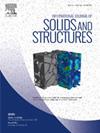Localizations and mode transition of cylindrical shells with geometrical imperfections under axial compression: Numerical and experimental investigations
IF 3.4
3区 工程技术
Q1 MECHANICS
International Journal of Solids and Structures
Pub Date : 2025-04-15
DOI:10.1016/j.ijsolstr.2025.113375
引用次数: 0
Abstract
The bending-dominated post-buckling deformations of cylindrical shells offer valuable opportunities for designing compliant mechanisms in soft materials. A deep understanding of the mechanics behind mode localization and transition phenomena is crucial for tailoring periodic mode shapes in shells. In this study, both finite element and experimental studies are conducted to explain the mechanics of circumferential snaking and mode jump phenomena using strain energy density as a key parameter. The numerical analysis reveals the complex interplay between the geometry and strain energy distribution during the snaking phenomenon. In this process, membrane strain energy stored in the structure is converted into bending strain energy, which is then redistributed to localized geometrical features within the periodic mode shape. Furthermore, the study examines the relationship between bending strain energy evolution and geometric transitions that occur during a mode jump, which leads to a reduction in the circumferential wave number of the shell’s periodic mode shape. Experimental validation is performed on 3D-printed cylindrical shells using a multi-3D Digital Image Correlation (DIC) setup. A methodology based on Sander-Koiter’s kinematics is developed to evaluate the full-field bending strain energy density distributions in the shells. The experimental results align with the numerical simulations, providing valuable insights into the nonlinear post-buckling behavior of cylindrical shells. These findings can be applied to the design of continuous compliant-shell mechanisms in soft robotics paving the way for advanced flexible mechanical systems.
轴向压缩下带几何缺陷圆柱壳的局部化和模态转变:数值和实验研究
弯曲主导的圆柱壳后屈曲变形为软材料柔顺机构的设计提供了宝贵的机会。深入理解模态局域化和跃迁现象背后的力学对于在壳中裁剪周期模态振型至关重要。本研究以应变能密度为关键参数,采用有限元和实验相结合的方法解释了环向蛇形和模态跳跃现象的机理。数值分析揭示了弯曲过程中几何形态与应变能分布之间复杂的相互作用。在这一过程中,储存在结构中的膜应变能被转换成弯曲应变能,然后被重新分配到周期模态振型内的局部几何特征上。此外,该研究还研究了弯曲应变能演化与模态跳跃期间发生的几何跃迁之间的关系,这种跃迁导致壳的周期模态振型的周向波数减少。利用多三维数字图像相关(DIC)装置对3d打印圆柱壳进行了实验验证。提出了一种基于Sander-Koiter运动学的弹壳全场弯曲应变能密度计算方法。实验结果与数值模拟结果一致,为圆柱壳的非线性后屈曲行为提供了有价值的见解。这些发现可以应用于软机器人中连续柔壳机构的设计,为先进的柔性机械系统铺平道路。
本文章由计算机程序翻译,如有差异,请以英文原文为准。
求助全文
约1分钟内获得全文
求助全文
来源期刊
CiteScore
6.70
自引率
8.30%
发文量
405
审稿时长
70 days
期刊介绍:
The International Journal of Solids and Structures has as its objective the publication and dissemination of original research in Mechanics of Solids and Structures as a field of Applied Science and Engineering. It fosters thus the exchange of ideas among workers in different parts of the world and also among workers who emphasize different aspects of the foundations and applications of the field.
Standing as it does at the cross-roads of Materials Science, Life Sciences, Mathematics, Physics and Engineering Design, the Mechanics of Solids and Structures is experiencing considerable growth as a result of recent technological advances. The Journal, by providing an international medium of communication, is encouraging this growth and is encompassing all aspects of the field from the more classical problems of structural analysis to mechanics of solids continually interacting with other media and including fracture, flow, wave propagation, heat transfer, thermal effects in solids, optimum design methods, model analysis, structural topology and numerical techniques. Interest extends to both inorganic and organic solids and structures.

 求助内容:
求助内容: 应助结果提醒方式:
应助结果提醒方式:


